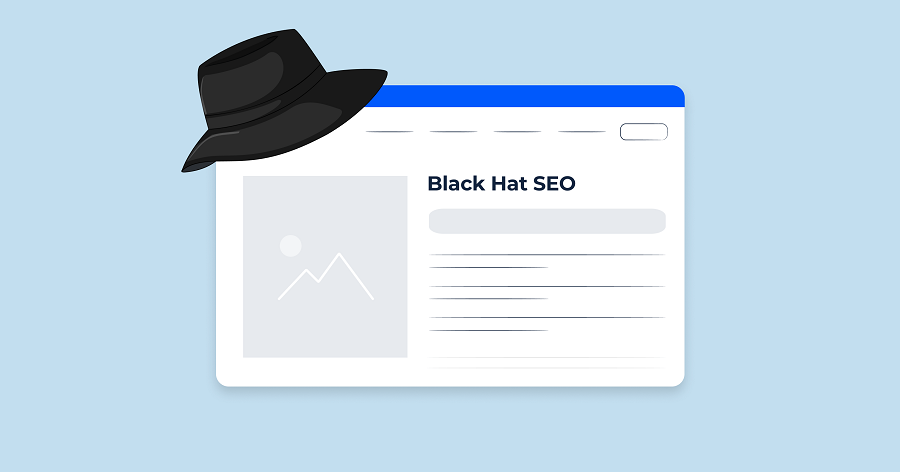The temptation to take shortcuts is strong in the ever-evolving digital landscape, where businesses vie for the coveted top spots on search engine results pages (SERPs). Enter black hat SEO, a set of unethical practices that promise quick wins but ultimately lead to devastating consequences.
This comprehensive guide will explore the shadowy world of black hat SEO, exposing its tactics, risks, and long-term effects. More importantly, we’ll show you how to avoid these deceptive techniques and build a sustainable, ethical SEO strategy that will endure.
What is Black Hat SEO?
Black hat SEO refers to a set of practices that violate search engine guidelines in an attempt to manipulate rankings. These tactics exploit search engine algorithm weaknesses to boost a site’s position on SERPs artificially. While white-hat SEO focuses on creating valuable content and improving user experience, black-hat SEO is all about tricking the system, often at the expense of user satisfaction.
The term “black hat” originates from Western movies, where the villains typically wore black hats to distinguish them from the “good guys” in white hats. In the SEO world, this analogy perfectly captures the ethical divide between those who follow the rules (white-hat SEO) and those who break them (black-hat SEO).
According to Google’s Webmaster Guidelines: “Avoid tricks intended to improve search engine rankings. A good rule of thumb is whether you’d feel comfortable explaining what you’ve done to a website that competes with you or to a Google employee. Another useful test is to ask, ‘Does this help my users? Would I do this if search engines didn’t exist?'”
The Risks of Black Hat
SEO While black hat SEO techniques might seem tempting, especially when you’re struggling to climb the SERP ladder, the risks far outweigh any potential short-term gains. Let’s break down these risks:
- Google Penalties: Search engines like Google constantly update their algorithms to detect and penalize sites using black hat SEO. These penalties can be algorithmic (automatic) or manual (reviewed by a human). The consequences? A significant drop in rankings or complete removal from search results.
- Loss of Trust: Even if you manage to rank high temporarily, users will quickly realize that your content needs to match their expectations. This erodes trust, leading to higher bounce rates, fewer conversions, and damage to your brand’s reputation.
- Short-Lived Success: Any gains from black hat SEO are fleeting. Search engines are getting smarter by the day, closing loopholes and refining their ability to detect manipulative tactics. What works today might lead to a catastrophic penalty tomorrow.
- Financial Impact: A sudden drop in organic traffic means fewer leads and sales. This can lead to significant revenue loss, layoffs, or even closure for many businesses. The cost of recovering from a penalty (if recovery is even possible) can be substantial.
- Industry Blacklisting: Once labeled as a black hat practitioner, regaining trust in the SEO community is incredibly hard. This reputation can follow you or your brand for years, challenging future projects.
9 Black Hat SEO Tactics to Avoid at All Costs
Keyword Stuffing
What it is: Overloading a page with keywords in an unnatural way to trick search engines into thinking the page is highly relevant for those terms.
Example: “Need outbound marketing software? Our outbound marketing software is the best outbound marketing software. Buy outbound marketing software from us because our outbound marketing software outperforms other outbound marketing software.”
How to Avoid It: Use keywords naturally within well-structured, valuable content. Tools like Yoast SEO or Rank Math can help monitor keyword density.
Buying Backlinks
What it is: Buying Backlinks from other websites to boost your domain authority artificially.
Why It’s Bad: Google’s guidelines strictly prohibit buying or selling links that pass PageRank. Both the buyer and seller can be penalized.
Safe Alternative: Earn backlinks through guest posting, collaborative articles, or by creating linkable assets like infographics or original research.
Article Spinning
What it is: Copying content from another site and rewording it, often using AI tools, to make it seem original.
Example: A spun article about Paris attractions might list the same places as another article but rephrase each sentence.
Why It’s Bad: It’s essentially plagiarism and offers no original value. Google penalizes duplicate or near-duplicate content.
Safe Alternative: Write original content in your own voice or update and expand your existing content with new insights and media.
Misusing Schema Markup
What it is: Adding inaccurate structured data to get richer snippets in SERPs.
Example: A seller adding fake 5-star reviews in their schema markup.
Why It’s Bad: It’s deceptive and violates Google’s rich snippet guidelines.
Safe Alternative: Use schema markup accurately and ethically, following Google’s guidelines.
Private Blog Networks (PBNs)
What it is: A group of websites, often on different topics, that link to each other to boost domain authority.
Why It’s Bad: Google sees this as an attempt to manipulate PageRank and can penalize all sites in the network.
Safe Alternative: Build authority through high-quality content that naturally attracts backlinks from diverse, reputable sites.
Blog Comment Spam
What it is: Posting comments on blogs solely to include a backlink to your site.
Example: “Great post! Check out my site [link] for more tips.”
Why It’s Bad: Commenting is spammy and often irrelevant, and most blogs now set comment links as “nofollow.”
Safe Alternative: Contribute meaningful comments and, if relevant, link to a helpful resource you’ve created.
Hidden Content
What it is: Concealing text or links by making them the same color as the background, setting font size to zero, or hiding behind images.
Why It’s Bad: It’s a deceptive way to stuff keywords without users seeing them.
Safe Alternative: There is none. All content should be visible and add value for users.
Non-Disclosed Sponsored Content
What it is: Publishing paid content or links without disclosing the commercial relationship.
Why It’s Bad: Google considers undisclosed paid links as link schemes.
Safe Alternative: Always use “nofollow” or “sponsored” attributes on paid links, and clearly label sponsored content.
Cloaking
What it is: Showing different content to users and search engines.
Example: Serving HTML text to crawlers but images to users or different content based on JavaScript settings.
Why It’s Bad: It’s a bait-and-switch that can expose users to ads, malware, or irrelevant content.
Safe Alternative: Make content accessible without cloaking, following Google’s guidelines.
Doorway Pages
What it is: Creating multiple pages targeting similar keywords redirecting to the same landing page.
Example: A site with all posts for “Understanding SEO,” “How to do SEO,” and “Do your own SEO” all lead to the same generic SEO service page.
Why It’s Bad: It’s misleading and clutters search results with near-duplicate content.
Safe Alternative: None. Focus on creating fewer, higher-quality pages that genuinely serve different user intents.
How to Report Black Hat SEO
Spotting a competitor using black hat tactics can be frustrating, especially if they’re ranking well. Here’s what you can do:
- File a Spam Report: Use Google’s spam report form to alert them about violations.
- Improve Algorithms: By reporting, you help Google refine its spam detection.
- Focus on Your Site: Instead of dwelling on competitors, make your own site better.
[Image: A screenshot of Google’s spam report form, encouraging ethical SEO practices.]
Remember, reporting isn’t about revenge but maintaining a fair playing field and helping search engines provide better results.
The SEO High Road: White Hat Techniques While black-hat SEO promises quick wins, white-hat SEO builds lasting success. Here are some ethical practices:
- Quality Content: Create original, valuable content that genuinely helps users.
- On-Page SEO: Optimize titles, meta descriptions, and headers, and use keywords naturally.
- Technical SEO: Improve site speed, mobile-friendliness, and crawlability.
- Earning Backlinks: Build relationships and create link-worthy content.
- User Experience: Focus on navigation, readability, and engagement.
Conclusion
The Future of SEO is Bright (and White). In the world of SEO, the temptation to take shortcuts is ever-present. Black hat SEO techniques offer the allure of quick rankings and fast traffic. But as we’ve seen, these unethical practices are a ticking time bomb. They don’t just risk penalties; they undermine the trust and credibility that make a brand successful online.
Search engines are more sophisticated than ever, armed with machine learning and human reviewers to catch those trying to game the system. What might work briefly today could lead to catastrophic consequences tomorrow. And in a digital age where brand reputation can be made or broken overnight, the risks of black hat SEO are simply too high.
Instead, embrace white-hat SEO. It’s not just about following the rules; it’s about aligning your goals with search engines and users. You build a sustainable online presence by creating valuable content, optimizing for a great user experience, and earning authority through merit. One that doesn’t just rank well but also converts visitors into loyal customers.
The future of SEO isn’t about outsmarting algorithms; it’s about serving humans better. Search engines increasingly favor sites that genuinely solve for the user as they get smarter. By staying on the ethical path, you’re not just avoiding penalties—you’re positioning your brand for long-term success in an ever-evolving digital landscape.
So, leave the black hat in the closet. In the world of SEO, the white hat isn’t just a symbol of ethics; it’s a crown of sustainable success.



